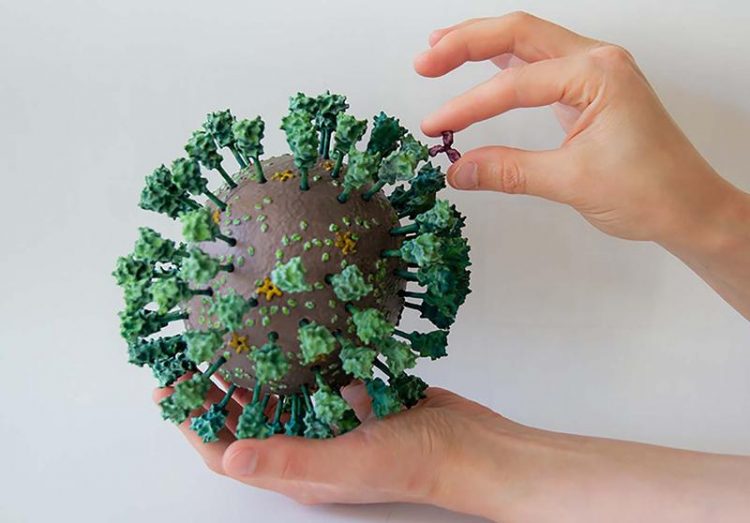Touchable corona viruses

Figure 1: The 3D printed model of the SARS-CoV-2 corona virus and an antibody in the scale 1 : 1,000,000. Rudolf-Virchow-Zentrum
Viruses are tiny. They cannot be seen with the naked eye and they are even too small for optical microscopes, which makes it difficult to recognize the danger that COVID-19 and its pathogen SARS-CoV-2 pose to the world.
This is why the international Coronavirus Structural Task Force led by Dr. Andrea Thorn from the Rudolf Virchow Center of the University of Würzburg has now developed a 3D model of the novel coronavirus which can even be touched.
The model measures 17 cm in diameter and can be printed with a normal 3D printer. The scientists study the molecules which make up the coronavirus and analyse it atom by atom. These findings went into the new model.
International team bundles expertise
23 researchers from seven different countries and different fields such as chemistry, physics, computer science and structural biology are working closely together to gain new insights into the inner workings of the virus.
They analyse every new molecular structure which is published, over 500 so far. Their make their improved molecular structures along with additional data available for drug developers worldwide in order to accelerate the development of a therapy or vaccines.
Making the state of knowledge accessible
What is remarkable about this model is its scientific accuracy: it realistically depicts the relative sizes and structures of the virus on a 1 : 1,000,000 scale. The virus hull carries not only the spike proteins (painted green in the photo) but two more types of protein molecules (lighter green and yellow).
As opposed to common depictions, the coronavirus is not exactly round or symmetrical, but can vary in shape and size.
Instructions for 3D printing and painting the virus model along with the necessary files are available at the Corona Structural Task Force homepage https://insidecorona.net/what-does-the-coronavirus-really-look-like/.
Interested parties can also find a state-of-the-art depiction of the viral infection cycle, as well as blog posts and information about the molecules of the virus on the homepage.
„We hope that this will make the virus more tangible“ says Thorn, hoping that the model will give children and adults alike an insight into the structural biology of the coronavirus.
About the Rudolf Virchow Center
The Rudolf Virchow Center is a central institution of the University of Würzburg. The research groups are working on key proteins are essential for cellular function and therefore central to health and disease.
Dr. Andrea Thorn (Rudolf Virchow Center, University of Würzburg, Germany)
Tel. 0931 31 83677, andrea.thorn@virchow.uni-wuerzburg.de
https://www.uni-wuerzburg.de/en/rvz/rvz-news/single/news/touchable-corona-viruse…
Media Contact
All latest news from the category: Life Sciences and Chemistry
Articles and reports from the Life Sciences and chemistry area deal with applied and basic research into modern biology, chemistry and human medicine.
Valuable information can be found on a range of life sciences fields including bacteriology, biochemistry, bionics, bioinformatics, biophysics, biotechnology, genetics, geobotany, human biology, marine biology, microbiology, molecular biology, cellular biology, zoology, bioinorganic chemistry, microchemistry and environmental chemistry.
Newest articles

Superradiant atoms could push the boundaries of how precisely time can be measured
Superradiant atoms can help us measure time more precisely than ever. In a new study, researchers from the University of Copenhagen present a new method for measuring the time interval,…

Ion thermoelectric conversion devices for near room temperature
The electrode sheet of the thermoelectric device consists of ionic hydrogel, which is sandwiched between the electrodes to form, and the Prussian blue on the electrode undergoes a redox reaction…

Zap Energy achieves 37-million-degree temperatures in a compact device
New publication reports record electron temperatures for a small-scale, sheared-flow-stabilized Z-pinch fusion device. In the nine decades since humans first produced fusion reactions, only a few fusion technologies have demonstrated…





















